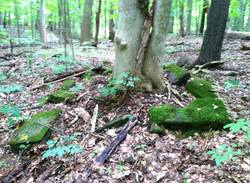Spring Houses and other mysteries
There are old, unmarked sites on the property that are mysteries. Remnants of crumbling walls; rabbit eared spigots in the middle of nowhere; stone blocks abandoned, lost, and now re-emerging as their covering soil erodes . When James and Nellie Kirby expanded their original property by buying up three adjoining farms, they didn’t have a compelling reason to immediately take down every outbuilding on every parcel. All they had to do was let the woods grow up through the former fields. If they took down a barn, they may have reused some of the foundations stones - but they probably left some alone and forgot about them. The Girl Scouts had no need to disturb them in their 75 years here.
So now there are these strange, undocumented ruins lurking in the woods. Many of these ruins are close to existing pathways because people tend to use existing roads even when land ownership changes. Farm lanes become hiking trails. And if a falling-down out building on an old country lane wasn’t bothering anybody, it continued its slow decay, helped by trees taking root in its fertile soil.
So now there are these strange, undocumented ruins lurking in the woods. Many of these ruins are close to existing pathways because people tend to use existing roads even when land ownership changes. Farm lanes become hiking trails. And if a falling-down out building on an old country lane wasn’t bothering anybody, it continued its slow decay, helped by trees taking root in its fertile soil.
Below: one of my favorite set of ruins at the park

It doesn’t look like much until you are almost on top of it. My guess is that it’s an old spring house that collapsed, allowing a tree to germinate in the wet soil inside.
There’s a great description of spring house construction and uses in the 4th volume of The Foxfire Books ( edited by Eliot Wigginton 1977, Anchor Books) A spring house is an enclosure around a place where cold water seeps from the ground. A stone-lined basin collects clean water. The overflow is allowed to escape, but not before cooling the interior of the little structure. Before there were refrigerators, spring houses kept food cold. Even wealthy families like the Neals built themselves a spring house near the main creek. ( see post from 3/8/2015 for a picture of the Neal’s springhouse )
It seems likely there would have been a house nearby this one. It would be fun to investigate further, but archeology is not a top priority at the moment when so much other work needs done. The spring house ruin can wait.
this article first appeared in FoCHlore- a history blog for the RJRD website
There’s a great description of spring house construction and uses in the 4th volume of The Foxfire Books ( edited by Eliot Wigginton 1977, Anchor Books) A spring house is an enclosure around a place where cold water seeps from the ground. A stone-lined basin collects clean water. The overflow is allowed to escape, but not before cooling the interior of the little structure. Before there were refrigerators, spring houses kept food cold. Even wealthy families like the Neals built themselves a spring house near the main creek. ( see post from 3/8/2015 for a picture of the Neal’s springhouse )
It seems likely there would have been a house nearby this one. It would be fun to investigate further, but archeology is not a top priority at the moment when so much other work needs done. The spring house ruin can wait.
this article first appeared in FoCHlore- a history blog for the RJRD website
